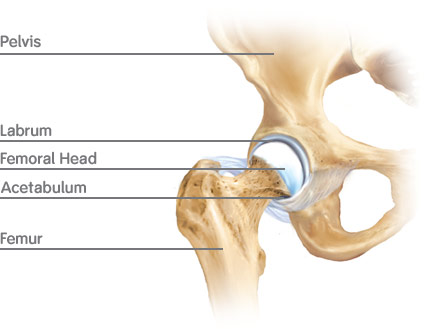the hip joint

anatomy and function
The hip, a ball-and-socket joint, is the largest weight bearing joint in the body. When the joint is healthy, the head of the femur (thighbone) forms a round ball that fits in to the acetabulum, a cavity at the base of the pelvis that forms the socket.
Ligaments connect the ball to the socket and keep them both firmly supported. The surfaces of the femoral head and the acetabulum are covered by a smooth, tough material known as articular cartilage, which cushions the bones and allows them to move easily. Around the rim of the acetabulum is a layer of fibrous cartilage called the labrum, which deepens the socket and provides a suction seal to hold the head of the femur firmly in place.
The other surfaces of the hip joint are covered by a thin, smooth tissue liner called the synovial membrane. This tissue produces a small amount of synovial fluid that acts as a lubricant and reduces the amount of friction that occurs when bones move against each other.
common hip problems
topCommon hip problems include:
hip impingement
Hip impingement is a disorder caused by a lack of room, or clearance, between the head and neck of the femur and the rim of the acetabulum. Due to this lack of clearance, when the hip is flexed, as in many common activities like running, sitting or bending over, the femur and the rim of the acetabulum rub together, causing significant pain in the joint. As a result of extensive contact between the femur and the acetabulum, the labrum may suffer damage, slowly degenerate, and may even cause arthritis in the hip over time.
Hip impingement is more common in athletic men, and any athletic or strenuous activity may further aggravate pain in the groin area caused by impingement. Remaining in a stationary seated position for extended periods of time may also aggravate the condition.
labral tears
The labrum is a layer of fibrous tissue covered in a synovial membrane that lines the rim of the socket in which the ball of the femur sits. This cartilage provides cushioning for the joint and keeps the femur in place. A tear in the labrum can result either from injury or from degeneration due to impingement or other joint conditions. Labral tears can be painful and may cause symptoms such as locking or “catching” in the joint and pain in the hip or groin area.
Since labral tears are often difficult to detect during a physical examination, a doctor may use magnetic resonance imaging (MRI) with a dye injection to confirm the diagnosis.
articular cartilage injuries
Articular cartilage is a layer of material in the hip joint that covers the surface of the femoral head and acetabulum, cushioning them and allowing them to move against each other without causing damage. This cartilage sometimes tears or becomes damaged, either from high impact sports like running or jumping, as a result of friction caused by hip impingement, or from basic wear and tear.
When articular cartilage is damaged, the torn fragment often protrudes into the joint, causing pain when the hip is flexed. Also, the bone material beneath the surface no longer has protection from joint friction, which may eventually result in arthritis if left untreated. Articular cartilage injuries often occur in conjunction with other hip injuries, and like labral tears, may require an MRI with a dye injection to confirm the diagnosis.
loose bodies
Removal of loose bodies (small loose fragments of cartilage or bone) is a common reason physicians perform arthroscopic hip surgery. These loose bodies are often the result of trauma, such as a fall, car accident or a sports-related injury, or they may result from degenerative disease. Loose bodies can cause a "catching" in the joint.
Unlike some hip conditions, loose bodies are relatively easy to detect with modern x-ray techniques.
snapping hip syndrome
Snapping hip syndrome (extra-articular lesions) is a medical condition characterised by a snapping sensation and an audible click upon flexion and extension of the hip joint.It may be painful in the lateral (outside) part of the hip, or pain may be experienced in the groin area. Snapping hip syndrome can be either internal or external, and usually develops as the result of an acute injury or overuse of the joint. Athletes are particularly at risk due to the repetitive hip flexion involved in sports such as ballet, football, resistance training, rowing, running and gymnastics1.
External snapping hip syndrome is associated with leg length differences1.
treatment options